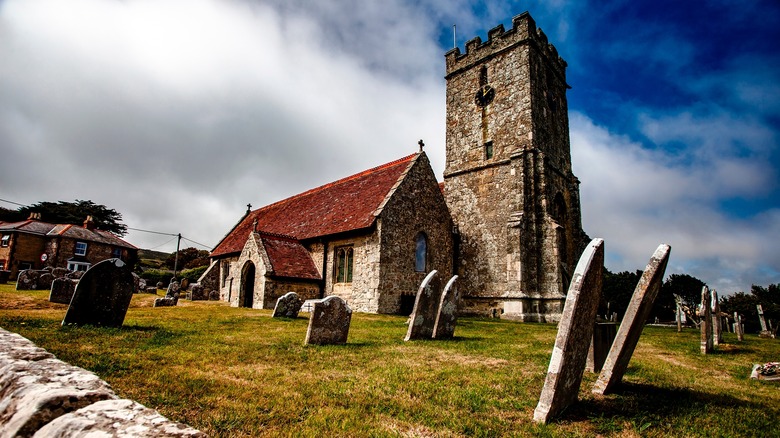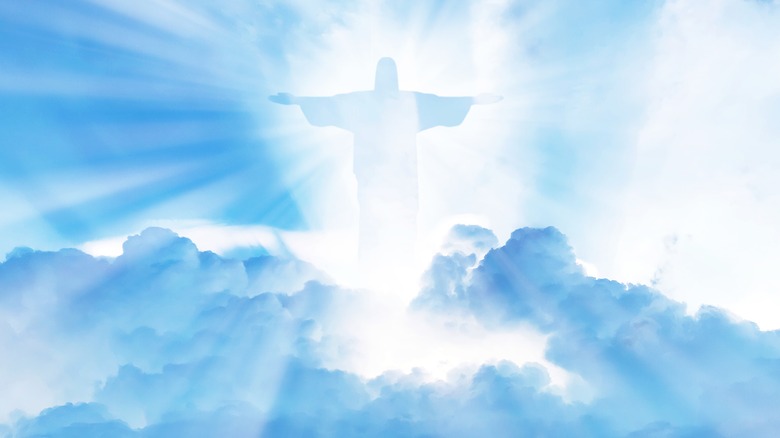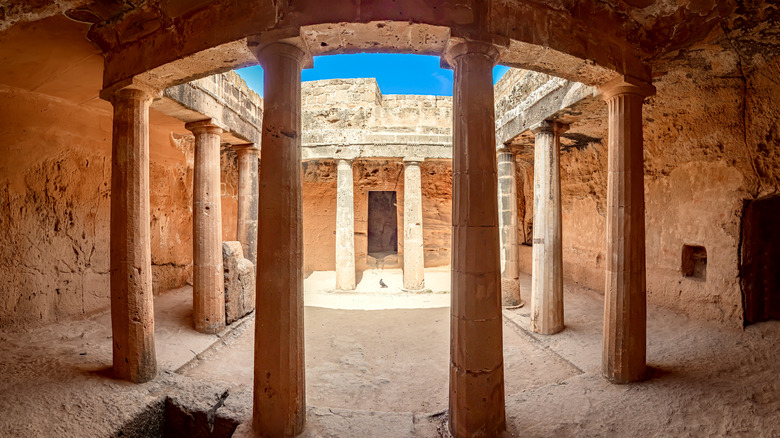The Real Reason Many Gravestones Face East
Death rites and funerary customs vary wildly across the world, from nation to nation, culture to culture, and religion to religion. Yes, caring for the dead might amount to two simple options: bury or burn (or sometimes mummify). And yes, there's generally some kind of memorial put in place for a person, some traditions outlining care for that memorial, and some ceremonies preceding the placement of that memorial. But along the way, we've got outlandish, animal-shaped "fantasy coffins" from Ghana, simple incense at a Japanese Buddhist funeral, funky, celebratory jazz funerals in New Orleans, coffins hanging from cliffs in China and in the Philippines, and much more. And of course, some Tibetans neither bury nor burn their dead, but leave them out in the open for carrion birds to eat in what are called "sky burials."
In comparison, plain old gray headstones in dry and scrubby cemeteries might seem a bit lackluster. But fear not: Even simple cemeteries house lore and secrets that folks might not know about, or have even thought about. For example, anyone who's strolled through a cemetery might have noticed that headstones are usually lined up in rows. Sure, this makes it easier to find and bury people, but sometimes headstones might all face the same direction, particularly east. If they do, as Milano Monuments says, it's likely that you're walking through a Christian cemetery. East-facing feet indicate hope for a Biblical resurrection of the body, and to literally rise to face Jesus when he returns to Earth.
Facing the second coming
So yes, it really is that simple: If the headstones in a cemetery face east, then that's representative of the Christian wish to return to life at the time of Jesus' much-awaited second coming. The Christian Bible isn't extremely specific on this point, but there are enough verses throughout its length to point to the tale of Jesus returning from the East.
Knowing Jesus has a list of such verses, which is probably more extensive even than many serious Christians realize. New Testament highlights include Matthew 24:27, "For just as the lightning comes from the east and flashes even to the west, so will the coming of the Son of Man be." The apocalyptic book Revelation talks about angels arriving on Earth with the "rising of the sun." Interestingly, the majority of the mentions of eastern wind, birds, kings, religious practices, etc., come from the Old Testament, indicating that the idea of "west vs. east" existed in Jewish consciousness long before the New Testament was written, as Verse by Verse Ministry touches on.
But even though the East has long held special significance in Judeo-Christian beliefs, the Center for Research Libraries says that designing cemeteries to place headstones along a west-east line only started as recently as 1831 with the U.S.' "Rural Cemetery Movement." Cemeteries and their design took on a romantic tone from that time, lockstep with the country's historical "romantic" literary and cultural movement from 1830 to 1870.
To welcome the rising sun
There's another, even older reason why graves face east, one far predating Christianity and the existence of cemeteries in modern-era countries like the U.S., but which might have influenced both of them: ancient Egyptian and Greek burial customs regarding the dead facing the rising sun, similar to what the Biblical book of Revelation describes.
Congressional Cemetery points to this connection, which makes sense given cross-cultural pollination through the Bronze Age (3,300 to 1,200 B.C.E.) and Iron Age (1,200 to 600 B.C.E.) between civilizations like Egypt, Sumer, Babylonia, Assyria, Greece, etc. These cultures, and particularly Greece, interacted with ancient Jews in the Levant like any other people and had an immense impact on ancient Rome, within which the Jewish province of Judea existed from about 64 B.C.E. to the fall of the Western Roman Empire in 476 C.E., as UNRV Roman History discusses. At minimum, it's true that some Greek peoples like the Megarians — there was no unified "Greek" culture, only separate city-states — faced their dead east, as the 1891 book "Burial Customs of the Ancient Greeks" describes. And so, customs regarding thanking the sun transformed into thanking the Son of God.
To some, like Sam Stoltzfus of Gordonville, Pennsylvania, all such explanations go without saying. To him, it's obvious that headstones would face east. On Lancaster Online he explains that all the dead in Gordonville's Amish cemetery face east. "When the Lord comes the second time," he says, "he'll come from the East."


